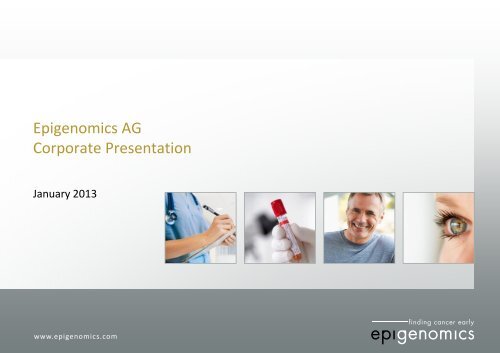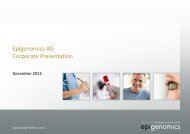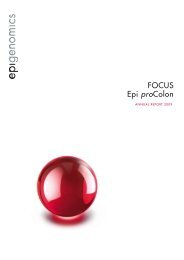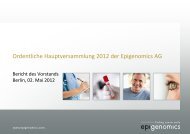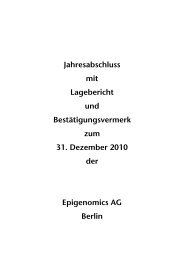Company Presentation January 2013 - Epigenomics AG
Company Presentation January 2013 - Epigenomics AG
Company Presentation January 2013 - Epigenomics AG
You also want an ePaper? Increase the reach of your titles
YUMPU automatically turns print PDFs into web optimized ePapers that Google loves.
<strong>Epigenomics</strong> <strong>AG</strong><br />
Corporate <strong>Presentation</strong><br />
<strong>January</strong> <strong>2013</strong><br />
www.epigenomics.com
Safe Harbor<br />
� Forward Looking Statements<br />
This communication contains certain forward-looking statements, including, without limitation, statements containing<br />
the words “expects”, “future”, “potential” and words of similar import. Such forward-looking statements involve known<br />
and unknown risks, uncertainties and other factors, which may cause our actual results of operations, financial condition,<br />
performance, or achievements, or industry results, to be materially different from any future results, performance or<br />
achievements expressed or implied by such forward-looking statements. Such factors include, among others, the following:<br />
uncertainties related to results of our clinical trials, the uncertainty of regulatory approval and commercial uncertainty,<br />
reimbursement and drug price uncertainty, the absence of sales and marketing experience and limited manufacturing<br />
capabilities, attraction and retention of technologically skilled employees, dependence on licenses, patents and proprietary<br />
technology, dependence upon collaborators, future capital needs and the uncertainty of additional funding, risks of product<br />
liability and limitations of insurance, limitations of supplies, competition from other biopharmaceutical, chemical and<br />
pharmaceutical companies, environmental, health and safety matters, availability of licensing arrangements, currency<br />
fluctuations, adverse changes in governmental rules and fiscal policies, civil unrest, acts of God, acts of war, and other factors<br />
referenced in this communication. Given these uncertainties, prospective investors and partners are cautioned not to place<br />
undue reliance on such forward-looking statements. We disclaim any obligation to update any such forward-looking<br />
statements to reflect future events or developments.<br />
� Legal Product Disclaimer<br />
Products by <strong>Epigenomics</strong> that are referred to in this presentation are not available for sale in the United States.<br />
The analytical and performance characteristics of any product to be eventually sold in the U.S. based on our technology<br />
have not been established.<br />
2 | <strong>January</strong> <strong>2013</strong>
Contents<br />
� <strong>Epigenomics</strong> overview<br />
� Epi proColon<br />
• Unmet need & opportunity<br />
• Characteristics & clinical data<br />
• US strategy<br />
� Epi proLung & future product opportunities<br />
� Summary<br />
� Appendix<br />
3 | <strong>January</strong> <strong>2013</strong>
<strong>Epigenomics</strong> at a Glance<br />
� <strong>Epigenomics</strong> is a leader in the field of DNA methylation based diagnostics for the early<br />
detection of cancer<br />
� <strong>Epigenomics</strong> has two promising commercial IVD tests with a CE mark:<br />
� <strong>Epigenomics</strong>’ near-term strategy is focused on obtaining FDA approval for Epi proColon®<br />
� <strong>Epigenomics</strong> completed its PMA filing of Epi pro Colon® to the FDA in 2012<br />
� A decision from the FDA is expected in the second half of <strong>2013</strong><br />
� <strong>Epigenomics</strong> is already building a customer base ahead of US approval. Currently over<br />
1,000 blood-based Septin9 laboratory-developed tests (LDT) are performed in the US weekly<br />
4 | <strong>January</strong> <strong>2013</strong><br />
� Addresses unmet need in the mass market of colorectal cancer (CRC)<br />
screening using the validated Septin9 biomarker<br />
� Is the first CE approved proprietary IVD test world wide that enables<br />
CRC screening based on a simple blood sample<br />
� Addresses unmet need in the niche market of difficult to diagnose lung<br />
cancer using the validated SHOX2 biomarker
Key Financials 9M 2012<br />
� Tightly controlled spending (incl. US commercial build-up)<br />
(in € thousand) 9M 2012 9M 2011<br />
Revenue 672 1,242<br />
EBIT (Operating Result) -9,430 -10,748<br />
(in € thousand) 09/30/2012 12/31/2011<br />
Liquid Assets* 6,187 13,985<br />
* incl. marketable securities<br />
� Operations in Germany and the US. Total current number of employees 35<br />
Full financial statements: http://www.epigenomics.com/en/news-investors/investors/financial-reports.html<br />
5 | <strong>January</strong> <strong>2013</strong>
Contents<br />
� <strong>Epigenomics</strong> overview<br />
� Epi proColon<br />
• Unmet need & opportunity<br />
• Characteristics & clinical data<br />
• US strategy<br />
� Epi proLung & future product opportunities<br />
� Summary<br />
� Appendix<br />
6 | <strong>January</strong> <strong>2013</strong>
Colorectal Cancer (CRC) Screening Saves Lives and Money;<br />
However 1 in 3 Screening Eligible Adults are not Screened<br />
CRC Screening Saves Lives and Money…<br />
� CRC is the second largest cancer killer in<br />
the US<br />
7 | <strong>January</strong> <strong>2013</strong><br />
140,000 new cases<br />
50,000 deaths 1<br />
� CRC is treatable if detected early enough<br />
� 5-year survival for diagnosed and treated<br />
Stage I/II CRC: 90%<br />
� Estimated US direct medical cost of CRC<br />
care in 2010 was $14 billion<br />
…However a Substantial Percentage of<br />
Citizens Remains Unscreened For CRC<br />
Colonoscopy<br />
35 million<br />
U.S. citizens<br />
are unscreened<br />
Stool<br />
based<br />
tests<br />
Key challenge: non-compliance to existing<br />
stool-based or invasive (colonoscopy)<br />
CRC screening options<br />
1) American Cancer Society.: Cancer Facts and Figures 2012. Atlanta, Ga: American Cancer Society, 2012.<br />
Graph: Centers for Disease Control. "Vital signs: Colorectal cancer screening, incidence, and mortality---United States, 2002-2010. " MMWR Morb. Mortal. Weekly Report. 2011, 60(26):884-889.
Blood-based CRC Screening: A Paradigm Shift Addressing Market Need<br />
When screening is easy/<br />
convenient and recommended<br />
by their provider:<br />
� More patients are screened<br />
� More cancers are detected<br />
early<br />
� Less deaths result from cancerrelated<br />
disease<br />
8 | <strong>January</strong> <strong>2013</strong><br />
Epi proColon: A Simple Blood Test for<br />
Early Detection of CRC<br />
Benefits for doctors and patients:<br />
� Non-invasive<br />
� No dietary/medication<br />
restrictions<br />
� Quick and easy, done anytime<br />
� Helps with screening resistant<br />
patients<br />
� Can be part of routine visits<br />
American Cancer Society.: Cancer Facts and Figures 2012. Atlanta, Ga: American Cancer Society, 2012. Centers for Disease Control.<br />
"Vital signs: Colorectal cancer screening, incidence, and mortality ---United States, 2002-2010 " MMWR Morb. Mortal. Weekly Report. 2011, 60(26):884-889.
Blood-based Screening is Widely Accepted<br />
62%<br />
Offer to participate in alternative screening<br />
methods to those who decline colonoscopy<br />
9 | <strong>January</strong> <strong>2013</strong><br />
38%<br />
87%<br />
pro<br />
colonoscopy<br />
against<br />
colonoscopy<br />
4% Blood test<br />
9%<br />
Stool test<br />
No screening<br />
Berlin Adherence Study Interim<br />
Results:<br />
� Study goal: to determine the<br />
demographic, health psychology<br />
and socio-economic traits<br />
associated with compliance to<br />
CRC screening guidelines.<br />
� Approx. 200 patients<br />
� Further surveys by Huntsman<br />
Cancer Center and others<br />
confirm these results in the US<br />
As presented at UEG 2012
Contents<br />
� <strong>Epigenomics</strong> overview<br />
� Epi proColon<br />
• Unmet need & opportunity<br />
• Characteristics & clinical data<br />
• US strategy<br />
� Epi proLung & future product opportunities<br />
� Summary<br />
� Appendix<br />
10 | <strong>January</strong> <strong>2013</strong>
Methylated Septin9 is a Suitable Marker for CRC Screening<br />
� Test consists of one single proprietary<br />
epigenetic biomarker:<br />
methylated Septin9 gene<br />
� Detection of free circulating tumor DNA in<br />
blood by real-time PCR test<br />
� Analytical sensitivity: down to 6 pg / ml<br />
� Strong patent position: biomarkers,<br />
technology, processes – <strong>Epigenomics</strong> own<br />
� 13 published retrospective clinical studies<br />
with more than 4,300 subjects<br />
� Two prospective clinical screening studies<br />
completed<br />
11 | <strong>January</strong> <strong>2013</strong>
CRC Detection in Right and Left Colon (Prof. Béla Mólnar)<br />
� Blinded case control study, 184 study participants,<br />
92 CRC cases (56 left-, 36 right-sided cases) – tested with<br />
gFOBT* and Septin9<br />
� Sensitivity for detection of left- and right-sided cases was<br />
96% and 94% respectively<br />
� Septin9 was confirmed as a highly sensitive biomarker for the detection of CRC in blood<br />
� Septin9 methylation level shows no difference between left and right side colon cancers<br />
12 | <strong>January</strong> <strong>2013</strong><br />
CRC<br />
sensitivity<br />
Left-sided<br />
cancers<br />
Right-sided<br />
cancers<br />
gFOBT* 68.2 83.3 50.0 70.6<br />
Septin9 95.6 96.4 94.4 84.8<br />
* guaiac Fecal Occult Blood Test<br />
Specificity<br />
Plasma Methylated Sept9 Is a Screening Marker in Both Left- and Right-Sided Colon Cancer. Comparison to FOBT and CEA Results Lead Author:<br />
Professor Dr. Kinga Toth from the 2nd Department of Internal Medicine of Semmelweis University in Budapest, Hungary Abstract No. u1895
Epi proColon®: One Assay – One Marker<br />
� Easy & fast: real-time PCR based,<br />
8 hours time to result<br />
� Compliant: cGMP manufactured,<br />
21 CFR Part 820 and ISO 13485 compliant;<br />
runs on Roche LC480 and AB7500.<br />
US product runs on FDA cleared<br />
real-time PCR device (AB7500 Fast DX)<br />
13 | <strong>January</strong> <strong>2013</strong><br />
•Fits into Current Lab Routine<br />
One Assay – One Marker -> Simple Qualitative Interpretation<br />
� CE marked for EU market<br />
� Automated: multiple volume dependent<br />
automation solutions possible<br />
� Flexible: adaptable to market requirements:<br />
high sensitivity or high specificity<br />
Not for sale or diagnostic use in the United States of America
Epi proColon®: Clinical Validation Study Data<br />
14 | <strong>January</strong> <strong>2013</strong><br />
Case control<br />
study (EU)<br />
September 2011<br />
Prospective<br />
screening study<br />
pivotal clinical trial for<br />
FDA submission<br />
FIT comparison<br />
study<br />
December 2012<br />
Samples 247 7,940* 300<br />
Sensitivity 95% 2 68% 1 71% 3<br />
Specificity 85% 2 80% 1 81% 3<br />
Assay / Kit<br />
Epi proColon®<br />
2.0 CE<br />
Epi proColon® 2.0<br />
Epi proColon® 2.0<br />
* tested samples selected from a prospectively collected cohort of 7.940 individuals at average risk for CRC. Tested samples included all CRC cases, all adenomas<br />
and significant number of polyps identified in this cohort in addition to a randomized selection of study individuals with no evidence of disease (NED)<br />
1) Prospective screening study results with Epi proColon® 2.0 final product published Dec 9, 2011<br />
2) Case control study results with Epi proColon® 2.0 final product published Sep 19, 2011 – also see slide 34 for set up - 3) study results published on Dec 4 th , 2012
Fecal Immunochemical Test (FIT) Comparison Study - Enrollment Metrics<br />
� FIT head-to-head comparison study protocol<br />
agreed with FDA and study started in Q2 2012<br />
completed Dec 04, 2012<br />
� FDA 510(k) cleared FIT test used is major<br />
commercial product in the US<br />
� Primary endpoint: demonstrate statistical<br />
non-inferiority of Epi proColon ® to FIT<br />
� Inclusion criteria: average risk, screening age,<br />
asymptomatic, no family history, no previous<br />
disease, screening colonoscopy<br />
� Blinded testing, FIT and Epi proColon®, performed<br />
at independent laboratory in the US<br />
� 70 sites throughout the US participated<br />
in the study<br />
� Testing was performed according to<br />
manufacturer’s IFUs (100 ng/ml cut-off for FIT)<br />
15 | <strong>January</strong> <strong>2013</strong><br />
104 valid cancer cases included<br />
(screening patients, matched samples<br />
taken 10 days post colonoscopy)<br />
103 with Septin9 result<br />
98 with FIT result<br />
198 valid asymptomatic<br />
average risk individuals<br />
(matched samples taken<br />
pre-colonoscopy, fully prospective)<br />
198 with Septin9 result,<br />
195 with FIT result<br />
� 3 CRC (excluded from analysis)<br />
� 25 advanced adenomas (25 with Septin9<br />
result, 24 with FIT result)<br />
� 73 small polyps<br />
� 97 subjects with no evidence of disease<br />
(97 with Septin9 result, 95 with FIT result)
Comparison Study Top Line Data: Sensitivity<br />
FIT<br />
Agreement between both methods: 62.2% (52.4 - 71.2%)<br />
Combined sensitivity: 87.8% (79.8 - 92.9%)<br />
16 | <strong>January</strong> <strong>2013</strong><br />
Epi proColon®<br />
- + total<br />
- 12 20 32<br />
+ 17 49 66<br />
total 29 69 98<br />
70% sensitivity<br />
(60.7-78.5%)<br />
67% sensitivity<br />
(57.6-75.8%)<br />
Non-inferiority to FIT in respect to sensitivity demonstrated!<br />
Head-to-head comparison study results with Epi proColon® and FIT published Dec 4, 2012
Comparison Study Top Line Data: Sensitivity by pT and CRC Stage<br />
Epi proColon® pT0/Tis pT1 pT2 pT3 pT4 pTx unknown TOTAL<br />
Stage 0 / I 2/3 4/8 8/11 - - - 0/1 14/23 60.9% (36.5-75.5%)<br />
Stage II - - - 10/14 2/2 - - 12/16 75.0% (50,5-89.8%)<br />
Stage III - 0/1 - 13/18 1/1 - - 14/20 70.0% (48.1-85.5%)<br />
Stage IV - 2/2 - 0/1 6/6 1/1 2/2 11/12 91.7% (64.4-99.6%)<br />
Unknown* - 1/1 - 1/1 - 6/6 14/24 22/32 68.8% (51.4-82.0%)<br />
TOTAL 2/3 7/12 8/11 24/34 9/9 7/7 16/27 73/103 70.9% (61.5-78.8%)<br />
*…Staging information incomplete or unavailable<br />
FIT pT0/Tis pT1 pT2 pT3 pT4 pTx unknown TOTAL<br />
Stage 0 / I 0/3 3/8 10/11 - - - 1/1 14/23 60.9% (45.4-82.8%)<br />
Stage II - - - 10/14 2/2 - - 12/16 75.0% (50.5-89.8%)<br />
Stage III - 1/1 - 15/18 1/1 - - 17/20 85.0% (64.0-94.8%)<br />
Stage IV - 1/1 - 0/1 4/6 1/1 1/2 7/11 63.6% (35.4-84.8%)<br />
Unknown* - 1/1 - 1/1 - 2/6 12/20 16/28 57.1% (39.1-73.5%)<br />
TOTAL 0/3 6/11 10/11 26/34 7/9 3/7 14/23 66/98 67.3% (57.6-75.8%)<br />
*…Staging information incomplete or unavailable<br />
17 | <strong>January</strong> <strong>2013</strong><br />
Head-to-head comparison study results with Epi proColon® and FIT published Dec 4, 2012
Comparison Study Top Line Data: Specificity (based on non-CRC cases)<br />
FIT<br />
18 | <strong>January</strong> <strong>2013</strong><br />
Epi proColon®<br />
- + total<br />
- 152 36 188<br />
+ 3 1 4<br />
total 155 37 192<br />
81% specificity<br />
(74,9-85,9%)<br />
98% specificity<br />
(94,8-99,2%)<br />
Agreement between both methods: 80% (73,4-84,8%)<br />
“Non-inferiority” to FIT (specificity)<br />
was statistically inconclusive<br />
Head-to-head comparison study results with Epi proColon® and FIT published Dec 4, 2012
Comparison Study Top Line Data:<br />
Detection of Advanced Adenoma and Small Polyps<br />
FIT<br />
19 | <strong>January</strong> <strong>2013</strong><br />
•Advanced Adenoma* Small Polyps*<br />
Epi proColon®<br />
- + Total<br />
- 21 2 23<br />
+ 0 1 1<br />
Total 21 3 24<br />
*…defined as high grade dysplasia or<br />
villous component, or >10 mm<br />
FIT<br />
Epi proColon®<br />
- + Total<br />
- 62 10 72<br />
+ 1 0 1<br />
Total 63 10 73<br />
*…defined as
Contents<br />
� <strong>Epigenomics</strong> overview<br />
� Epi proColon<br />
• Unmet need & opportunity<br />
• Characteristics & clinical data<br />
• US strategy<br />
� Epi proLung & future product opportunities<br />
� Summary<br />
� Appendix<br />
20 | <strong>January</strong> <strong>2013</strong>
FDA Submission Status: Completed in 2012<br />
21 | <strong>January</strong> <strong>2013</strong><br />
Pre-IDE meeting<br />
Preliminary data<br />
review and module<br />
plan determination<br />
�<br />
Module 1<br />
manufacturing and<br />
quality system<br />
sections<br />
�<br />
Module 2<br />
software validation &<br />
instrumentation<br />
Premarket<br />
approval<br />
submission<br />
(PMA)<br />
�<br />
Module 3<br />
analytical validation<br />
Module 4<br />
clinical validation<br />
�<br />
�<br />
� Filing completed in 2012, feedback on first modules received,<br />
ongoing and constructive dialogue with FDA (no major obstacles encountered so far)<br />
� Panel meeting expected to be convened by FDA upon review of submitted data
Building a Customer Base Ahead of US Approval<br />
Increased Adoption of Septin9<br />
� Available coast-to-coast in the US<br />
� Continuous growth of Septin9 testing through<br />
LDT partners: Quest, ARUP, Companion Dx<br />
(recently launched) and Gamma Dynacare<br />
� >1,000 tests per week in North America<br />
� LDT partners likely to become future<br />
<strong>Epigenomics</strong> customers<br />
� CPT code 81401 announced and payment<br />
being established<br />
� Payer dialogue with private insurers & CMS ongoing<br />
22 | <strong>January</strong> <strong>2013</strong>
Expected US Product Launch of Epi proColon® in <strong>2013</strong><br />
Pre-launch<br />
Private payer & CMS<br />
dialogue for reimbursement<br />
Enlist thought leaders &<br />
MAB to guide launch<br />
Leverage LDT partner test<br />
marketing<br />
Build proprietary core<br />
commercial team<br />
23 | <strong>January</strong> <strong>2013</strong><br />
Pre- and post-<br />
launch<br />
Create awareness through<br />
publications, medical<br />
conferences & symposia<br />
Educate clinical labs,<br />
primary care and GI<br />
Target advocacy groups to<br />
drive public awareness<br />
Perform health<br />
economic studies<br />
FDA approval<br />
Post-launch<br />
Guideline inclusion<br />
Adherence & compliance<br />
studies<br />
Expand proprietary<br />
commercial team<br />
Direct marketing efforts
Contents<br />
� <strong>Epigenomics</strong> overview<br />
� Epi proColon<br />
• Unmet need & opportunity<br />
• Characteristics & clinical data<br />
• US strategy<br />
� Epi proLung & future product opportunities<br />
� Summary<br />
� Appendix<br />
24 | <strong>January</strong> <strong>2013</strong>
Epi proLung® - Market Introduction<br />
� Marketed in Europe since mid-2010<br />
� Reflex test for the diagnosis of lung cancer<br />
� Biomarker: methylated SHOX2 gene<br />
� Increasing awareness and interest in expert<br />
community<br />
� Market introduction through academic studies<br />
25 | <strong>January</strong> <strong>2013</strong><br />
CE validation<br />
study 2010<br />
Study by Charité Berlin 2012 - 228 samples analyzed<br />
Epi proLung®<br />
performance<br />
Cytology<br />
Epi proLung® combined<br />
with cytology<br />
Sensitivity 81% 77% 77% 98%<br />
Specificity 95% 97% 95% 92%
R&D Capabilities and Future Product Opportunities<br />
Biomarker discovery,<br />
confirmation and selection<br />
� <strong>Epigenomics</strong>’ core capabilities and proprietary technology enabling epigenetic<br />
biomarker discovery and IVD development<br />
� <strong>Epigenomics</strong>’ DNA methylation biomarkers have broad IP protection: 70 active patent<br />
families and licenses provide extensive protection for markers and methods<br />
� <strong>Epigenomics</strong> has identified and validated over 20 proprietary prognostic, predictive,<br />
response, diagnostic, and screening biomarkers in colorectal cancer, lung cancer,<br />
prostate cancer, and bladder cancer<br />
� Internal development is currently focused on Epi proColon®, <strong>Epigenomics</strong> actively<br />
pursues license opportunities for several biomarkers<br />
26 | <strong>January</strong> <strong>2013</strong><br />
•core capabilities<br />
IVD test development,<br />
validation and regulatory<br />
Commercialization
Contents<br />
� <strong>Epigenomics</strong> overview<br />
� Epi proColon<br />
• Unmet need & opportunity<br />
• Characteristics & clinical data<br />
• US strategy<br />
� Epi proLung & future product opportunities<br />
� Summary<br />
� Appendix<br />
27 | <strong>January</strong> <strong>2013</strong>
•ACHIEVEMENTS<br />
•UPCOMING MILESTONES<br />
Recent Achievements & Upcoming Milestones: 2011 - <strong>2013</strong><br />
Signed Septin9 option agreement<br />
with QI<strong>AG</strong>EN N.V.<br />
Restructured operations:<br />
focus on the US<br />
28 | <strong>January</strong> <strong>2013</strong><br />
EU launch of Epi proColon® 2.0 CE<br />
Completed FIT comparison study<br />
Filed 4 modules of PMA to FDA<br />
Supervisory and Management<br />
Board changes implemented<br />
2011 2012 <strong>2013</strong><br />
Securing of additional<br />
financial resources<br />
Commercial<br />
Development<br />
Corporate<br />
Receive decision from FDA<br />
on Epi proColon PMA<br />
Develop automation solutions<br />
Launch Epi proColon® in the US<br />
Drive sales and adoption in Europe<br />
Seek additional partnerships
Why Invest in <strong>Epigenomics</strong>....<br />
29 | <strong>January</strong> <strong>2013</strong><br />
� Epi proColon®: the world’s first IVD test for early<br />
detection of colorectal cancer in blood<br />
� Methylated Septin9: the world’s most thoroughly<br />
validated biomarker for blood based CRC detection<br />
- Prospectively validated<br />
- Proven utility in CRC early detection<br />
- Globally available as IVD (EU) or LDT (US)<br />
- Under FDA review as IVD for the US market<br />
� IVD test for lung cancer diagnosis in the EU market<br />
� Attractive pipeline of epigenetic biomarkers for<br />
numerous applications<br />
� Strong partnerships: IVD companies and laboratories
Thank You for Your Attention!<br />
Contact Investor Relations<br />
Europe U.S.A.<br />
Antje Zeise<br />
Manager Investor Relations<br />
<strong>Epigenomics</strong> <strong>AG</strong><br />
T +49 30 24345 0<br />
ir@epigenomics.com<br />
www.epigenomics.com<br />
Christine Yang<br />
Vice President<br />
The Trout Group LLC<br />
T +1 646 378 2929<br />
cyang@troutgroup.com<br />
TICKER<br />
Bloomberg: ECX:GR<br />
Reuters: EXXG.DE<br />
Thomson ONE: ECX-XE<br />
INTERNET<br />
www.epigenomics.com<br />
www.epiprocolon.com<br />
www.epiprolung.com
Contents<br />
� <strong>Epigenomics</strong> overview<br />
� Epi proColon<br />
• Unmet need & opportunity<br />
• Characteristics & clinical data<br />
• US strategy<br />
� Epi proLung & future product opportunities<br />
� Summary<br />
� Appendix<br />
31 | <strong>January</strong> <strong>2013</strong>
CRC Tumorgenesis and Septin9<br />
32 | <strong>January</strong> <strong>2013</strong>
Septin9 Tests: Continious Improvement as Assay Technology Evolved<br />
Sensitivity / Specificity<br />
100%<br />
90%<br />
80%<br />
70%<br />
60%<br />
50%<br />
40%<br />
30%<br />
20%<br />
10%<br />
0%<br />
33 | <strong>January</strong> <strong>2013</strong><br />
1 2 3 4 5 6 7 8 9 10 11 12 13<br />
Technology Development<br />
1 st Gen. Tests Epi proColon®<br />
Case Control Studies<br />
5.000<br />
4.500<br />
4.000<br />
3.500<br />
3.000<br />
2.500<br />
2.000<br />
1.500<br />
1.000<br />
500<br />
0<br />
Subjects tested (cumulative)
Epi proColon® 2.0: Powerful Screening Tool with Flexible Set Up<br />
34 | <strong>January</strong> <strong>2013</strong><br />
Method Specificity Sensitivity Positive<br />
Predictive Value 3)<br />
Epi proColon® 2.0 CE*<br />
(marketed in Europe) 1) 99.3% 80.6% 45.7%<br />
OC-Sensa Micro qFIT1x2 2) 93.7% 69.2% 7.5%<br />
1) Tetzner et al. UEGW 2011, 2 Allison et al. 1996 NEJM, 2) Park et al. 2010. Am. J. Gastro.<br />
3) Orange figure: CRC with positive test result, grey figure: healthy with positive test result assuming a prevalence for CRC of 0.7%.


